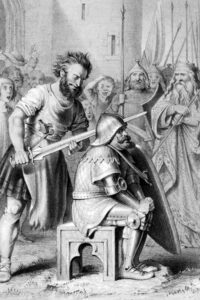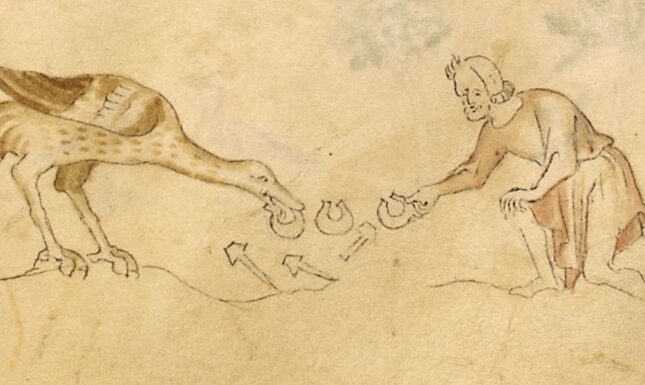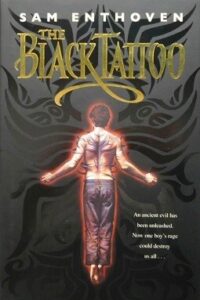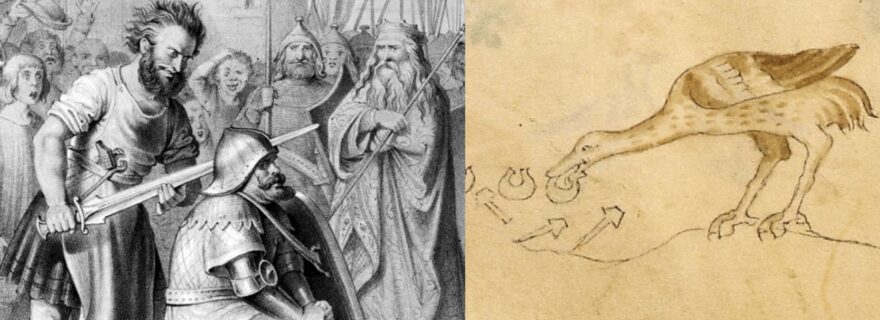Of Germanic heroes, sword-making, and bird poop
Learn more about the curious case of a sword made from bird dung...
You might wonder what something as unsightly as bird excrement has to do with a thing as magnificent as a heroic sword. The answer lies in an old Germanic legend, where bird excrements play a curious role in the making of a sword, and the process is as fascinating as it is unusual. Whether a myth or a now-forgotten technique, this unusual practice brings us from smithies in Central Asia to stories and legends of the Germanic Middle Ages, and even to a Contemporary Young Adult Novel. So, grab a cup of good mead and prepare for a short literary journey about the bizarre use of bird droppings in sword-making...
Of Heroes and Dung
The Þiðreks saga af Bern (Saga of Dietrich von Bern) is an Old Norse saga that tells the story of Þiðrek (or Dietrich) von Bern, a character based on the historical figure of Theoderic the Great (454-526). The saga blends history and legends, as is typical of medieval heroic literature. Alongside Þiðrek’s story, the text includes episodes centred on other characters, such as Velent, a master blacksmith in Germanic legends, also known as Vǫlundr in the Poetic Edda and Wēland in Old English literature.


In the section of the Saga known as Velents þáttr smiðs, the short tale of Velent the smith, Velent engages in a bet against King Nidung’s smith, Amilias. He must craft a sword capable of cutting through the helm and armour made by the royal smith. Before the bet, Velent puts the sword to the test by cutting a piece of felt that is carried by the river’s stream and, though the blade cuts it neatly in two, he is not satisfied with the result. He then files the sword into dust, collects the filings, and combines them with a meal that he serves to some domestic fowl that have been starving for three days. He takes their droppings, brings them to the forge and uses them to mould the sword again. He repeats the process twice before reaching the desired result. This leads to the crafting of the renowned sword Mimmung, which is later wielded by Velent’s son, Viðga, in the same saga and by the semi-legendary hero Waldere in the eponymous Old English poem.
One may link this episode with Beowulf l. 1032 feola laf, “the remains of the file”. Has this “notable kenning[1]
for sword”, as per Klaeber’s commentary, a connection with this seemingly befouled technique? This can only be speculative, as I am not aware of any other evidence corroborating this controvertible hypothesis. However, It is to be noted that kennings often have a distant mythological or legendary origin, as exemplified by Snorri Sturluson in Skáldskaparmál, the second part of the Prose Edda.
[1] A kenning (pl. kennings or kenningar) is a compound expression (i.e., a compound noun or a phrase of two or more words) in old Germanic poetry with metaphorical meaning. Some famous examples from Beowulf are hronrad (l. 10, whale-way, i.e the sea) or hildeleoma (ll. 1143, 2583, battle-lightning, the sword).
The Medieval Legend of Metal-Eating Ostriches
Interestingly, there exists a commonality with a legend that brings us all the way to the Orient. In manuscripts from the Middle Ages, ostriches were often depicted with a horseshoe or a nail in their mouth, due to their reputed ability to digest anything. The legend was widespread in Europe and Asia, and among its most ancient sources, we find Pliny the Elder’s description of struthocameli (ostriches) in his Natural History, X, 1: concoquendi sine dilectu devorata mira natura (its digesting of the objects that it swallows down indiscriminately is a wonder of nature). The Sum of Knowledge about Precious Stones (1041-1050) by the Iranian scholar Al-Biruni describes the process of feeding iron to ostriches in order to obtain the metal in a suitable state for making swords. According to the text, the Rus, a Germanic people, and Slavs were familiar with and utilized this technique.
In 13th-century Europe, while an anonymous author in Norway was compiling the Þiðreks saga, the legend’s veracity was put to the test. In his De Animalibus (On Animals), the German philosopher Albertus Magnus reports the results of an experiment he performed, in which Ostriches would swallow rocks and broken bones, but would not touch metal. In De la Pirotechnia (On Pyrotechnics, 1540), the Italian master craftsman Vannoccio Biringuccio, expresses his mistrust about this sword-making technique that was supposedly used in Damascus. This proves that, notwithstanding the scepticism, the legend endures in medieval Europe.

In 13th-century Europe, while an anonymous author in Norway was compiling the Þiðreks saga, the legend’s veracity was put to the test. In his De Animalibus (On Animals), the German philosopher Albertus Magnus reports the results of an experiment he performed, in which Ostriches would swallow rocks and broken bones, but would not touch metal. In De la Pirotechnia (On Pyrotechnics, 1540), the Italian master craftsman Vannoccio Biringuccio, expresses his mistrust about this sword-making technique that was supposedly used in Damascus. This proves that, notwithstanding the scepticism, the legend endures in medieval Europe.
The Legend Today: Sam Enthoven’s The Black Tattoo (2006).

Over time, the myth has endured and ultimately made its way into Sam Enthoven's The Black Tattoo (2006). The story follows Charlie, a young boy who is possessed by a demon, known as the Scourge, which manifests itself on his body in the form of a tattoo. In the novel, the character of Raymond shares similarities with Velent. He is a much-skilled smith and uses an unusual sword-making method, which involves breaking a blade into shards, feeding them to pigeons, collecting their excrement, and re-melting the pieces. The nitrogen in the droppings, as Raymond explains, acts as a hardening agent. He repeats the process seven times, and the resulting blade he fittingly called the Pigeon Sword. As the smith explains to the young protagonist:
"The Saxons were where I heard it first," said Raymond blithely. "They used chickens. But the Arabs, Toledo — most everyone was at it at some time or another. Some Eastern swordsmiths even used ostriches, if you believe the stories" (98).
In a way, this account summarises perfectly the short literary journey we are just about to end. The Þiðreks saga, in fact, has likely been translated from a Low German original (Hall 2013: 4). Low Germany has been inhabited by a Germanic People known as the Saxons, from which the second part of the compound “Anglo-Saxon” comes from: they were among the Germanic tribes who migrated in Great Britain between the 5th and 6th century AD; and as we all know, Beowulf was composed in Anglo-Saxon England.
"BeFowled" Theories
One may wonder whether there is a kernel of truth to the episode from the Þiðreks saga. It may sound like a load of... well, you know. However, some studies explored the possible use in sword-making of animal as a source for nitrogen, just as Raymond does in his novel H. Coghlan examined an Iron Age sword containing nitride needles and suggested that the iron may have been heated using an ammonia-bearing fuel, such as animal excrement. E. Salin went even further by conducting an experiment with a duck, suggesting that smiths may have encouraged birds and poultry to peck at the bright particles scattered around the smithy. They would have later retrieved the content from their stomachs for further use. In Salin’s opinion, this process may free iron particles from slag. From these scholars’ perspectives, the historical use of this technique does not seem so far-fetched.
Other theories do not substantiate the idea that the method has been in actual use and consider it a mere legend. In 2006, R. Hoyland and B. Gilmour associated the origin of the myth with the production of crucible steel in Central Asia. They suggested that the egg-shaped steel ingots produced in the region may have contributed to the fabrication of the legend, which spread to Europe with the migrations occurring in the middle of the first millennium AD; later, the legend made its way back to the east with the Vikings’ trading journeys. Unfortunately, the debate seems to lack a clear-cut answer.
Whether based on a myth or a long-forgotten legitimate technique, the narrative of sword-making through bird excrement serves as a testament to either humankind’s ingenuity or to its fancy. Unlike horseshoes for ostriches, the use of bird droppings in sword-making may be a difficult concept to digest. But, as sometimes the unlikeliest of materials can yield the strongest results, so the most reluctant of minds might yield to the plausibility of such an ancient and widespread account. The Italian singer-songwriter Fabrizio de Andrè, inspired by Baudelaire’s Les Fleurs du Mal, once sang: dai diamanti non nasce niente / dal letame nascono i fiori (From diamonds, nothing grows / from manure, flowers grow). Indeed, a product of refined craftmanship such as the legendary sword Mimmung required the appalling use of manure to reach its perfection; allegedly, many other well-wrought swords may have undergone a similar process in a long-forgotten past.
Bibliography
- Buquet, T. 2013 (updated: 2015). “Fact Checking: Can Ostriches Digest Iron?”. Medieval Animal Data Network [04-04-2023].
- Coghlan, H. 1956. ‘Etruscan and Spanish Swords of Iron’. Sibrium, 3: 167-174.
- Davidson H.E. 1994. The Sword in Anglo-Saxon England: its Archaeology and Literature. Woodbridge: The Boydell Press.
- Enthoven, S. 2006. The Black Tattoo. London: Doubleday
- Hall, A. 2013. “Jón the Fleming: Low German in thirteenth-century Norway and fourteenth-century Iceland”. Leeds Working Papers in Linguistics and Phonetics 18: 1-33.
- Hall M.E. 1995. “Viking Age Ironworking: The Evidence from Old Norse Literature”. Kroeber Anthropological Society Papers 78: 195-203.
- Klaeber, F. et al. 2008. Klaeber’s Beowulf and the Fight at Finnsburg. Toronto: University of Toronto Press.
- Kucypera, P. 2017. “Metal, swords, and birds. A myth spanning time, place, and cultures”. Fasciculi Archaeologiae Historicae 30: 53-58.
- Plinius the Elder, 1906. C. Plini Secundi naturalis historiae libri XXXVII. Mayhoff, K.F.T. ed. Leipzig: B.G. Teubner. Consulted via Perseus Digital Libraries.
- Salin É. 1957. La Civilisation Mérovingienne daprès les sépultures, les textes et le laboratoire. Vol 3/4: Les Techniques. Paris: Éditions A. et J. Picard et Co.


